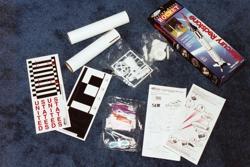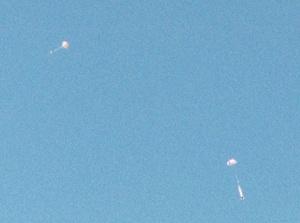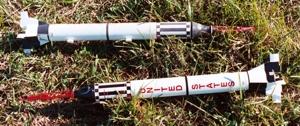Estes Mercury Redstone
Estes - Mercury Redstone {Kit} (1241, K-41) [1969-1981]
Contributed by Tim Burger
| Construction Rating: | starstarstar_borderstar_borderstar_border |
| Flight Rating: | starstarstarstarstar_border |
| Overall Rating: | starstarstar_borderstar_borderstar_border |
| Manufacturer: | Estes  |
 Brief: This is a scale model of the second manned Mercury/Redstone, Liberty Bell 7
Brief: This is a scale model of the second manned Mercury/Redstone, Liberty Bell 7
Forward: This kit was as a prize from EMRR; thanks for the kit! I don’t really know how to classify this model. It isn’t a true scale model, exactly, since the instructions (which feature very few actual instructions) do not include a scale finish nor anything remotely resembling scale documentation. Also, the bulk of the main components are plastic, but it isn’t ready fly, nor even almost ready to fly. It requires little painting, but again, isn’t scale that way. Like I said, I’m a little hard pressed to classify it. Since this is a review, I’ll attempt to do it the manufacturer’s way and resist the temptation to make a lot of changes or deviate from the order set out by the instructions. I will add a few comments about producing a better scale model as I go for those who are interested in my opinion.
Construction: The parts all come in the standard bag with the new wrap-around cardboard insert. The plastic parts come in two bags: capsule parts in one baggy, and another bag of fins with tape wrapped around the points to prevent them damaging other parts. There was a third package of other components including the ’chutes, motor mount tube, hook, plastic internal parts, etc. Two body tubes with a pre-finished white outer layer were included. Of those, one has pre-cut holes for the lugs, and pre-cut slots for the fins. Also floating around in the bag were a motor block and a tube coupler. Finally there is a set of instructions - term “instructions” used loosely. There are a few sentences here and there, and in a few places a description (such as “black paint”) but the rest is almost completely diagrams and illustrations. A picture is worth a thousand words, and all!
One starts with the motor mount. A slot is made near one end, the motor hook is placed in the slot and captured by a thin plastic ring with some glue. The block is then glued into the top end, and this assembly is then glued to a pair of plastic disks - one at the top and another at the bottom. These two parts have a lip such that the motor mount tube is firmly pinched between them. The illustration shows that grooves and notches in the two disks need to be lined up; plastic model cement (tube type) is used. Next, four stringers are added between the two disks and mate in the notches - they sort of snap in and tube cement is used to fix them there. These become an internal frame in which the plastic fins are glued later.
While the motor assembly dries, the escape tower and rocket are assembled. This assembly is formed from three ladder frames that are glued to the capsule’s “hat.” The rocket motor bells, and jettison rocket motor are glued to the bottom of the main motor. These are allowed to dry, then added to the ladder assembly. If you are going for an all out scale model, paint the ladders, motor bells, jettison motor and “hat” before you assemble them! The base ring around the hat should be aluminum or silver, the rest of the nose should be flat black, and the ladder and motor should be bright red (the instructions make no mention and show no illustration regarding this). The tube molded into the main escape motor along the side should be black. Paint the inside of the bells black while you are at it. This will produce a much nicer model than the method shown in the plans.
The capsule is assembled next. The capsule is the highlight of the kit - well molded with lots of detail. This is the sole thing that gives this kit the potential to be a beautiful model. The main capsule is made of four main parts - three panels and a base. The top “hat” and escape assembly then rides on that. You assemble the panels on the base, being careful to match the parts as shown so the detail comes out right. The glue is applied to the base, the parts installed, then the top added. Bottle (liquid) cement is then run along the seems from the inside. A smart fellow would glue the parts to the base, use a rubber band to hold the tops together and glue the inside. He would mask off the shoulder, and spray the bottom of the capsule lightly with bright red. After the red is dry, mask along the rim, then spray the capsule with flat black. This would produce a black capsule with a red ring along the bottom. Then glue on the top and escape tower assembly. A much prettier, easier to detail capsule is the result. But wait! Close inspection of this capsule reveals that it is really a scale model of the MR7 flight, not the MR8 flight. Whoa! The booster decals are for MR7, not MR8. What’s the deal, here? The capsule decals are MR8, and there is only one “United States” decal (there should be two.) I checked to make sure that I haven’t lost any decals, thinking that maybe it comes with two sets so you can choose, but no. Guess a scale modeller isn’t supposed to notice the non-scale decals.
 The instructions now have the builder install the motor mount in the lower body tube with the framework previously made carefully lined up with the slots. Tube type cement is used for this. The upper and lower launch lug guides are now installed. The decals are put on the main tube at this time. These are the stick-on type, but are a really thin material so they look OK. I used a sharp knife and a rule to cut out the decals - one should cut just inside the dashed lines, leaving no lines to mar the finish. The wraps are a little tricky to get on straight, but with the launch lugs as a starting guide this can be done well. A sharp knife is now used to trim away the material over the slots. The fins are all glued in at this point using tube cement. I had a bit of difficulty with this as the pointed end of the fins weren’t keen to meet the tubing well. They needed held for a long time while the cement set up, and even then didn’t stick well to the shiny surface of the decals. I eventually resorted to using CA.
The instructions now have the builder install the motor mount in the lower body tube with the framework previously made carefully lined up with the slots. Tube type cement is used for this. The upper and lower launch lug guides are now installed. The decals are put on the main tube at this time. These are the stick-on type, but are a really thin material so they look OK. I used a sharp knife and a rule to cut out the decals - one should cut just inside the dashed lines, leaving no lines to mar the finish. The wraps are a little tricky to get on straight, but with the launch lugs as a starting guide this can be done well. A sharp knife is now used to trim away the material over the slots. The fins are all glued in at this point using tube cement. I had a bit of difficulty with this as the pointed end of the fins weren’t keen to meet the tubing well. They needed held for a long time while the cement set up, and even then didn’t stick well to the shiny surface of the decals. I eventually resorted to using CA.
The two halves of the body tube are now joined using wood glue and the coupler ring. The stripe around the middle is positioned, the upper wrap added, and the decals proclaiming “United States” are placed on. I used a straight edge and a pencil to make a light line down the tube where the long lines of text go to aid in getting them square. The line was then erased.
Of course, assembling the rocket in this manner produces a nice flyable rocket; however it isn’t very pretty, really. The spirals stand out! The decals are a lot shinier than the rest of the tube, and the seam, though covered, is very visible. Sigh. I’ve already touched on the inconsistant decals. So if you want to make a nice rocket and produce a booster worthy of the stunningly well done nose (you did paint it before assembling, didn’t you?) then some time spent on the booster body will be necessary. Unfortunately, to do the job correctly will require reordering the steps. First, because of the way the upper launch lug is made, you must glue it in prior to joining the tubes. Join the tubes before installing the decals and fins and then spend some time filling and sanding the spiral and tube joint. Then lay on a couple of layers of white sandable primer with a light sanding between coats. Find the problems and fix them! Now a nice layer or two of gloss white paint. Now add the decals, fins, and remaining lug. It will turn out much nicer and you will be a lot happier with it.
Last, the shock cord is added to the body tube in the standard Estes way. A length of shroud line is included for the nose - a loop is tied around the escape tower and then to the base. The ’chute is added at a place where the nose balances. The instructions do not show this, but add a short length of shock cord elastic between the ’chute and the capsule shroud.
Construction Rating: 2 out of 5 Out of the bag instructions produce a ho-hum end product. This kit does have the potential to be a 5 out of 5 if done carefully.
Flying:
 This model was flown at the club’s October launch on a C6-5. It was a little windy and cool. The body was filled with the recommended number of sheets of recovery wadding. The capsule ’chute was folded and placed in first, followed by the carefully folded booster ’chute (the idea being that the capsule’s ’chute will pull out the booster’s ensuring a good recovery. The motor mount is very tight; I wasn’t able to get the motor fully locked in under the hook, but had it jammed in well enough that I couldn’t get it back out so I wasn’t worried about it kicking. It was loaded on the pad, and the LCO kindly waited for a low point in the wind before counting down. The rocket flew arrow straight, ejected just past apogee, and opened both ’chutes. The two parts stayed close on the way to the ground and landed a 100 or so yards from the pads, and about 10 feet from each other. Picture perfect. Several people stopped by my area to eyeball the old and the new and comment on the flight.
This model was flown at the club’s October launch on a C6-5. It was a little windy and cool. The body was filled with the recommended number of sheets of recovery wadding. The capsule ’chute was folded and placed in first, followed by the carefully folded booster ’chute (the idea being that the capsule’s ’chute will pull out the booster’s ensuring a good recovery. The motor mount is very tight; I wasn’t able to get the motor fully locked in under the hook, but had it jammed in well enough that I couldn’t get it back out so I wasn’t worried about it kicking. It was loaded on the pad, and the LCO kindly waited for a low point in the wind before counting down. The rocket flew arrow straight, ejected just past apogee, and opened both ’chutes. The two parts stayed close on the way to the ground and landed a 100 or so yards from the pads, and about 10 feet from each other. Picture perfect. Several people stopped by my area to eyeball the old and the new and comment on the flight.
Flight Rating: 4 out of 5
Cheers:Nice nose cone! (To bad it’s a Freedom 7 not Liberty Bell 7)
Jeers: Awful body tube! The decals do not match - you get capsule decals for MR8, but MR7 Booster decals and a MR7 scale capsule. The instructions could really use some work. While the illustrations are OK and adequate for successfully building a flyable rocket, they miss completely producing a decent scale model and waste a high potential kit. Since the fins are plastic and required molding any way why don’t they have any detail - particularly where the exhaust vanes are?
Overall Rating: 2 out of 5 Misses a decent scale model by so much but yet so little! How ironic! (or is that moronic?)
On a side note, this is the third Mercury Redstone that Estes has produced since I’ve been building and flying rockets. The first was released quite a long while ago - I recall making one in the early Eighties. It was a slightly different scale and came with a turned balsa cone. The cone was wrapped with a printed card stock sheet with the details printed on it. The tower assembly came in the bag as a few hardwood dowels. Each part of the three ladders was cut to length, sanded to fit, and assembled over the plans much like the stick and tissue model plane builders do. The fins were slabs of balsa, and as I recall, you cut them to shape, sanded the cross section of the exhaust vanes with a sanding block, and added the aerodynamic fins and plates to the ends. There was a reason it was a skill level 4! Tedious but rewarding.
 The second release used the same cone as the current release, but was a single, standard Estes tube that required paint and came with a nice set of water slide decals. I currently still have one of these kits, and it has been known to place very high in contests. A young person in our club has one of these new kits, however, and has gone the extra length to make hers a truly nice model and my days of walking away with a ribbon are numbered, I fear!
The second release used the same cone as the current release, but was a single, standard Estes tube that required paint and came with a nice set of water slide decals. I currently still have one of these kits, and it has been known to place very high in contests. A young person in our club has one of these new kits, however, and has gone the extra length to make hers a truly nice model and my days of walking away with a ribbon are numbered, I fear!
Other Reviews
- Estes Mercury Redstone By David Fergus
This is a single stage high quality replica of Gus Grissom's Liberty Bell 7 approx 1/50th scale designed for B & C engines. This kit is unique from every other Estes kit I have bought or built in a number of ways... The package says skill level 2, but it compares to other level 3 kits from Estes. This kit recently went on sale, supposedly a reissue of an earlier Estes kit. I obtained ...
 |
 |
Flights
Sponsored Ads
 |
 |











